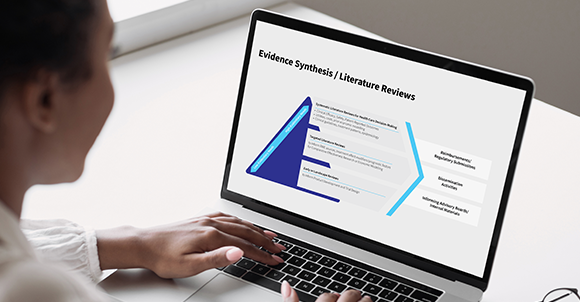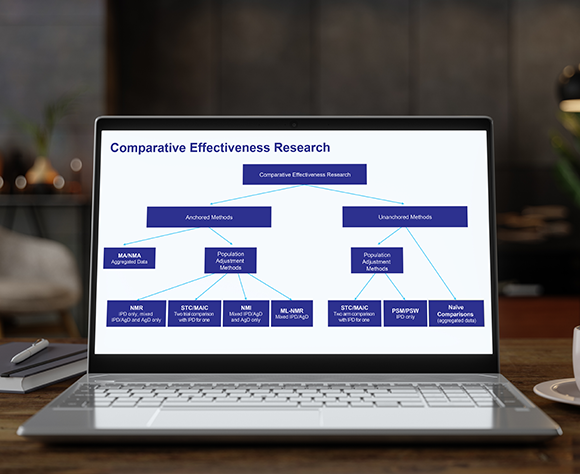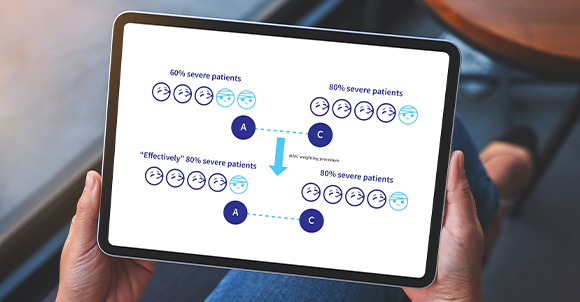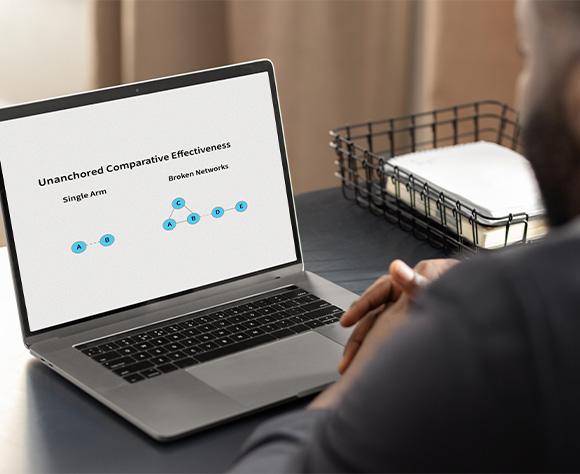Our Publications
- Russell-Smith TA, Gurskyte L, Muresan B, Mamolo CM, Gezin A, Cappelleri JC, Heeg B. Efficacy of non-intensive therapies approved for relapsed/refractory acute myeloid leukemia: a systematic literature review.
Future Oncol. 2022 Feb 24. - Klein A, Cremer P, Kontzias A, Furqan M, Forsythe A, Crotty C, Lim-Watson M, Magestro M. Clinical Burden and Unmet Need in Recurrent Pericarditis: A Systematic Literature Review.
Cardiol Rev. 2022 Mar-Apr 01;30(2):59-69.
- Kwon CS, Daniele P, Forsythe A, Ngai C. A Systematic Literature Review of the Epidemiology, Health-Related Quality of Life Impact, and Economic Burden of Immunoglobulin A Nephropathy.
J Health Econ Outcomes Res. 2021 Sep 1;8(2):36-45. - Sarda SP, Sarri G, Siffel C. Global prevalence of long-term neurodevelopmental impairment following extremely preterm birth: a systematic literature review.
J Int Med Res. 2021 Jul;49(7):3000605211028026. - D'Andrea E, Vinals L, Patorno E, Franklin JM, Bennett D, Largent JA, Moga DC,Yuan H, Wen X, Zullo AR, Debray TPA, Sarri G. How well can we assess the validity of non-randomised studies of medications?
A systematic review ofassessment tools. BMJ Open. 2021 Mar 24;11(3):e043961. - Grabner M, Strati E, Sandman K, Forsythe A. Economic burden of acute steroid-refractory graft-versus-host disease in commercially insured pediatric patients.
J Manag Care Spec Pharm. 2021 May;27(5):607-614. - Dolph M, Tremblay G, Gilligan AM, Leong H. Network Meta-Analysis of Once Weekly Selinexor-Bortezomib-Dexamethasone in Previously Treated Multiple Myeloma.
J Health Econ Outcomes Res. 2021 Aug 25;8(2):26-35. - Prawitz T, Popat R, Suvannasankha A, Sarri G, Hughes R, Wang F, Hogea C, Ferrante SA, Gorsh B, Willson J, Kapetanakis V. DREAMM-2: Indirect Comparisons of Belantamab Mafodotin vs. Selinexor + Dexamethasone and Standard of Care Treatments in Relapsed/Refractory Multiple Myeloma.
Adv Ther. 2021 Nov;38(11):5501-5518. - Fahrbach K, Sarri G, Phillippo DM, Neupane B, Martel SE, Kiri S, Reich K.Short-Term Efficacy of Biologic Therapies in Moderate-to-Severe PlaquePsoriasis: A Systematic Literature Review and an Enhanced Multinomial NetworkMeta-Analysis.
Dermatol Ther (Heidelb). 2021 Dec;11(6):1965-1998. - Muresan B, Mamolo C, Cappelleri JC, Leip E, Viqueira A, Heeg B. An indirect comparison between bosutinib, nilotinib and dasatinib in first-line chronic phase chronic myeloid leukemia.
Curr Med Res Opin. 2021 May;37(5):801-809. - Tremblay G, Tomaras D, Strati E, Forsythe A. Comparative Effectiveness of Remestemcel-L-rknd versus Ruxolitinib in Pediatric Patients with Steroid- Refractory Acute Graft-Versus-Host Disease using Simulated Treatment Comparisons.
J Health Econ Outcomes Res. 2021 Feb 23;8(1):10-17. - Tremblay G, Daniele P, Bell T, Chan G, Brown A, Cappelleri JC. Comparative effectiveness of glasdegib versus venetoclax combined with low-dose cytarabine in acute myeloid leukemia.
J Comp Eff Res. 2021 May;10(7):603-612. - Hashim M, Pfeiffer BM, Bartsch R, Postma M, Heeg B. Do Surrogate Endpoints Better Correlate with Overall Survival in Studies That Did Not Allow for Crossover or Reported Balanced Postprogression Treatments? An Application in Advanced Non-Small Cell Lung Cancer.
Value Health. 2018 Jan;21(1):9-17.
- Gebregergish SB, Hashim M, Heeg B, Wilke T, Rauland M, Hostalek U. The cost- effectiveness of metformin in pre-diabetics: a systematic literature review of health economic evaluations.
Expert Rev Pharmacoecon Outcomes Res. 2020 Apr;20(2):207-219. - Wigfield P, Sbarigia U, Hashim M, Vincken T, Heeg B. Are Published Health Economic Models for Chronic Hepatitis B Appropriately Capturing the Benefits of HBsAg Loss? A Systematic Literature Review.
Pharmacoecon Open. 2020 Sep;4(3):403-418. - Lee LJ, Kwon CS, Forsythe A, Mamolo CM, Masters ET, Jacobs IA. Humanistic and Economic Burden of Non-Muscle Invasive Bladder Cancer: Results of Two Systematic Literature Reviews.
Clinicoecon Outcomes Res. 2020 Nov 23;12:693-709. - Munshi NC, Avet-Loiseau H, Anderson KC, Neri P, Paiva B, Samur M, Dimopoulos M, Kulakova M, Lam A, Hashim M, He J, Heeg B, Ukropec J, Vermeulen J, Cote S, Bahlis N. A large meta-analysis establishes the role of MRD negativity in long- term survival outcomes in patients with multiple myeloma.
Blood Adv. 2020 Dec 8;4(23):5988-5999. - Sarri G, Patorno E, Yuan H, Guo JJ, Bennett D, Wen X, Zullo AR, Largent J, Panaccio M, Gokhale M, Moga DC, Ali MS, Debray TPA. Framework for the synthesis of non-randomised studies and randomised controlled trials: a guidance on conducting a systematic review and meta-analysis for healthcare decision making.
BMJ Evid Based Med. 2020 Dec 9:bmjebm-2020-111493. - Hungria V, Martínez-Baños DM, Mateos MV, Dimopoulos MA, Cavo M, Heeg B, Garcia A, Lam A, Machnicki G, He J, Fernandez M. Daratumumab Plus Bortezomib, Melphalan, and Prednisone Versus Standard of Care in Latin America for Transplant-Ineligible Newly Diagnosed Multiple Myeloma: Propensity Score Matching Analysis.
Adv Ther. 2020 Dec;37(12):4996-5009. - Sbarigia U, Vincken T, Wigfield P, Hashim M, Heeg B, Postma M. A comparative network meta-analysis of standard of care treatments in treatment-naïve chronic hepatitis B patients.
J Comp Eff Res. 2020 Oct;9(15):1051-1065. - Mateos MV, San-Miguel J, Goldschmidt H, Sonneveld P, Dimopoulos MA, Heeg B, Hashim M, Deraedt W, Hu P, Lam A, He J. The effects of different schedules of bortezomib, melphalan, and prednisone for patients with newly diagnosed multiple myeloma who are transplant ineligible: a matching-adjusted indirect comparison.
Leuk Lymphoma. 2020 Mar;61(3):680-690. - Dimopoulos MA, Cavo M, Mateos MV, Facon T, Heeg B, van Beekhuizen S, Gebregergish SB, Nair S, Pisini M, Lam A, Slavcev M. A matching-adjusted indirect treatment comparison (MAIC) of daratumumab-bortezomib-melphalan- prednisone (D-VMP) versus lenalidomide-dexamethasone continuous (Rd continuous), lenalidomide-dexamethasone 18 months (Rd 18), and melphalan-prednisone- thalidomide (MPT).
Leuk Lymphoma. 2020 Mar;61(3):714-720. - Forsythe A, Zhang W, Phillip Strauss U, Fellous M, Korei M, Keating K. A systematic review and meta-analysis of neurotrophic tyrosine receptor kinase gene fusion frequencies in solid tumors.
Ther Adv Med Oncol. 2020 Dec 21;12:1758835920975613.
- Sarri G, Guo Y, Iheanacho I, Puelles J. Moderately severe and severe acute pancreatitis : a systematic review of the outcomes in the USA and European Union-5.
BMJ Open Gastroenterol. 2019 Feb 16;6(1):e000248. - Tremblay G, Westley T, Forsythe A, Pelletier C, Briggs A. A criterion-based approach to systematic and transparent comparative effectiveness: a case study in psoriatic arthritis.
J Comp Eff Res. 2019 Nov;8(15):1265-1298. - Tremblay G, Westley T, Cappelleri JC, Arondekar B, Chan G, Bell TJ, Briggs A. Overall survival of glasdegib in combination with low-dose cytarabine, azacitidine, and decitabine among adult patients with previously untreated AML: comparative effectiveness using simulated treatment comparisons.
Clinicoecon Outcomes Res. 2019 Sep 6;11:551-565. - Cortes JE, Muresan B, Mamolo C, Cappelleri JC, Crescenzo RJ, Su Y, Gambacorti-Passerini C, Heeg B, Douglas Smith B. Matching-adjusted indirect comparison of bosutinib, dasatinib and nilotinib effect on survival and major cytogenetic response in treatment of second-line chronic phase chronic myeloid leukemia.
Curr Med Res Opin. 2019 Sep;35(9):1615-1622. - Tremblay G, McElroy HJ, Westley T, Meier G, Misurski D, Guo M. Indirect treatment comparisons including network meta-analysis: Lenvatinib plus everolimus for the second-line treatment of advanced/metastatic renal cell carcinoma.
PLoS One. 2019 Mar 5;14(3):e0212899. - Aly M, Hashim M, Heeg B, Liwing J, Leval A, Mehra M, Lawson J, Brookman-May SD, Akre O. Time-to-event Outcomes in Men with Nonmetastatic Castrate-resistant Prostate Cancer-A Systematic Literature Review and Pooling of Individual Participant Data.
Eur Urol Focus. 2019 Sep;5(5):788-798. - Forsythe A, Kwon CS, Bell T, Smith TA, Arondekar B. Health-related quality of life in acute myeloid leukemia patients not eligible for intensive chemotherapy: results of a systematic literature review.
Clinicoecon Outcomes Res. 2019 Jan 14;11:87-98.
- Forsythe A, Brandt PS, Dolph M, Patel S, Rabe APJ, Tremblay G. Systematic review of health state utility values for acute myeloid leukemia.
Clinicoecon Outcomes Res. 2018 Jan 25;10:83-92. - Tremblay G, Chandiwana D, Dolph M, Hearnden J, Forsythe A, Monaco M. Matching-adjusted indirect treatment comparison of ribociclib and palbociclib in HR+, HER2- advanced breast cancer.
Cancer Manag Res. 2018 May 22;10:1319-1327. - Forsythe A, Chandiwana D, Barth J, Thabane M, Baeck J, Tremblay G. Progression-free survival/time to progression as a potential surrogate for overall survival in HR+, HER2- metastatic breast cancer.
Breast Cancer (D0ve Med Press). 2018 May 4;10:69-78. - Forsythe A, Chandiwana D, Barth J, Thabane M, Baeck J, Shor A, Tremblay G. Is progression-free survival a more relevant endpoint than overall survival in first-line HR+/HER2- metastatic breast cancer?
Cancer Manag Res. 2018 May 4;10:1015-1025.
- Forsythe A, Christian R. Effectiveness of prophylactic intravenous immunoglobulins in preventing infection in pediatric oncology patients: a systematic review protocol.
JBI Database System Rev Implement Rep. 2016 Dec;14(12):48-55. - Gianoukakis AG, Flores NM, Pelletier CL, Forsythe A, Wolfe GR, Taylor MH. Treatment patterns, health state, and health care resource utilization of patients with radioactive iodine refractory differentiated thyroid cancer.
Cancer Manag Res. 2016 May 30;8:67-76. - Sarri G, Bennett D, Debray T, Deruaz-Luyet A, Soriano Gabarró M, Largent JA, Li X, Liu W, Lund JL, Moga DC, Gokhale M, Rentsch CT, Wen X, Yanover C, Ye Y, Yun H, Zullo AR, Lin KJ. ISPE-endorsed guidance in using electronic health records for comparative effectiveness research in COVID-19: opportunities and trade-offs.
Clin Pharmacol Ther. 2022 Feb 16. - Nahi H, Våtsveen TK, Lund J, Heeg BM, Preiss B, Alici E, Møller MB, Wader KF, Møller HE, Grøseth LA, Østergaard B, Dai HY, Holmberg E, Gahrton G, Waage A, Abildgaard N. Proteasome inhibitors and IMiDs can overcome some high-risk cytogenetics in multiple myeloma but not gain 1q21.
Eur J Haematol. 2016 Jan;96(1):46-54.










_580x302px.jpg)


_580x302px.jpg)
_580x474px.jpg)
_580x302px.jpg)

_580x302px.jpg)
.jpg)


